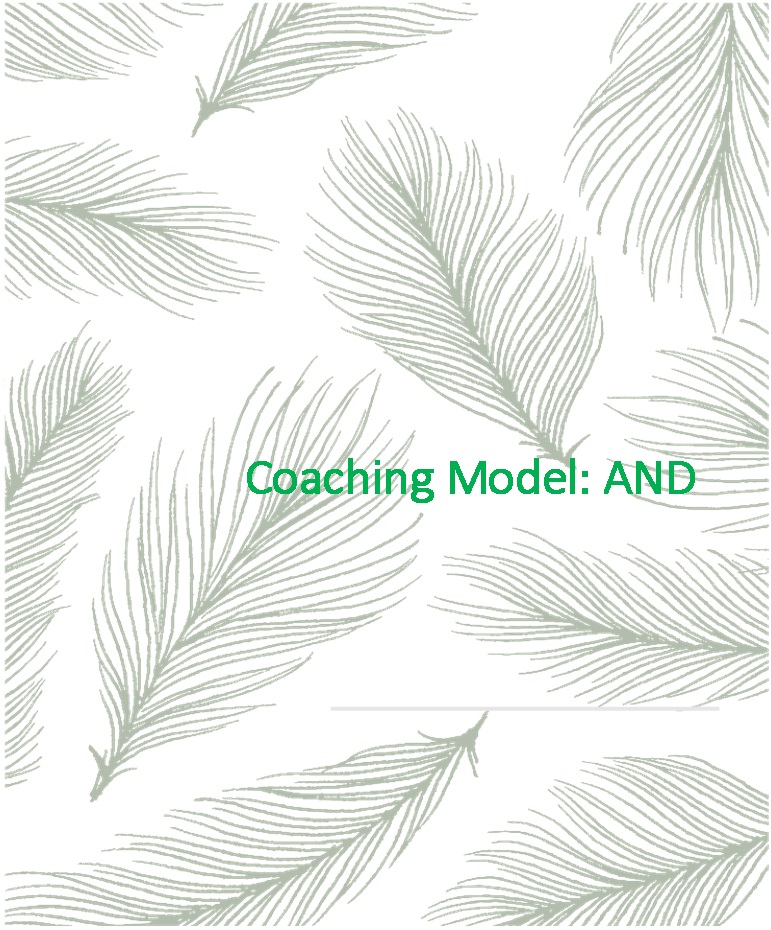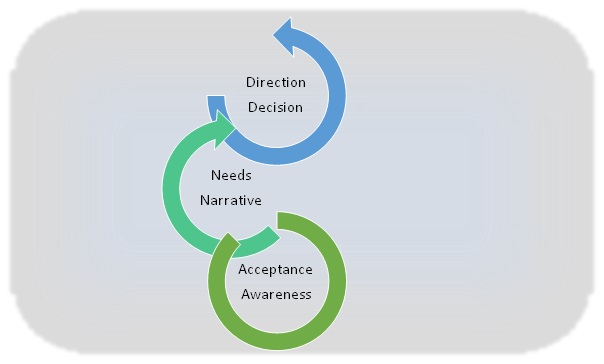A Coaching Power Tool Created by Petya Wienand
(Communication Coach, BULGARIA)

creating Awareness about  core Needs and taking Direction.
core Needs and taking Direction.

Summary
The AND Model is about how we make sense of the world by how we connect. It is a coaching model that supports clients to unravel and focus their potential in a direction they desire, to connect to others in personal life and at work in more authentic, meaningful, and constructive ways. It does that based on the understanding that to be authentic in communication does not mean choosing between two alternatives/perspectives/views, to strain and struggle in a dilemma: between work or life, between being true to oneself or loyal to somebody else. It is about finding your unique way, to feel free to make connections and to establish healthy and respectful boundaries between self and others.
The AND Model focuses on how we relate to ourselves and others. How we relate impacts on how we feel, whom we choose as a partner or friends, what motivates us, what decisions we make, ultimately, the quality of our life. How we relate comes from our core need to belong(Baumeister & Leary, 1995), which is often challenged in the fast-paced 21st-century world. How we make sense of where we belong is one of the principal pillars of what makes us happy, alongside, the needs for autonomy and mastery (Ryan and Deci, 2001; Eyal, 2020).
The underlying idea is that often the way we view the world tends to become binary, in terms of either…or…. Such view closes our perspective, skews reality, excludes, hurts relationships, and what is worse, drains our energy and drives us to build our identity through negative motivation, i.e. what we are against, versus what we are for. The model challenges this binary thinking through creating awareness and accepting differences as enriching. It builds on expanding one’s perspective of how our core needs come out in the narrative of “who I am” without the constraints of binary thinking, of having to choose between two extremes. Ultimately, shedding such a burden moves us towards clarity of intent, decision, and direction.
The AND Model takes into consideration that authenticity is about identity, and identity is stable and fluid at the same time(Shapiro, 2017). It builds on clarifying the boundary between what the client views as their core and stable identity and where the client could influence a change in the direction they would like.
The guiding metaphor chosen for this model is the olive tree, symbolic of peace, peace of mind, and focus. This is embedded in the chosen name “AND”, symbolic of the meaning of unity, peace, and harmony. Thus, the model assumes that personal growth and development, i.e. the outcome of a coaching process, necessarily, is based on peace of mind, internal harmony (alignment) with one’s values and authenticity. Such are also the characteristics of building harmonious relationships based on dignity and respect.
Finally, the AND Model is about transformational change.
Who is the Model for?
Process
The Model consists of six major components based on the abbreviation AND. They form the root of the Olive tree, i.e. the basis for unraveling the client’s potential for a transformative change.
- Awareness: creating awareness is the first step towards clarity about where the client is then and where they would like to be. Awareness is built through exploring perceptions, beliefs, thoughts, feelings, and how these are expressed in the behavior.
- Acceptance: before proceeding to the desired change, the client accepts where they are at that point in their specific context. Through this acceptance, the client overcomes the futile resistance to change and accepts what cannot be changed. This releases energy to commit towards the desired change and to acquire control over what can be changed. Acquiring control increases the client’s confidence and feeling that they can make a meaningful difference and can choose the direction of their life.
- Needs: based on the acquired awareness in the coaching process, the client identifies their core needs (e.g. for autonomy, recognition/appreciation/mastery, belonging) underlying their aspirations to the desired goal. Often core needs are hidden in the interpretations we make about contexts and remain unmet. By becoming aware of core needs, new opportunities open to satisfy them.
- Narrative: based on the core needs, the client identifies the core values that will guide them towards the desired goal(Brown, 2018). This identification changes and expands the client’s narrative of the specific context in a way that reconsiders limiting beliefs, open new possibilities, and makes their goals tangible and achievable. In the iterated narrative the client builds a more wholesome perspective and feels enabled to tap on their strengths and resourcefulness to move forward.
- Decision: based on the expanded and enriched conscious narrative, the client makes their decisions as to what they would like to change to achieve the goal they have set for themselves.
- Direction: with the new decision from coaching, a direction is taken up with more clarity, as all meaningful changes require becoming part of a lifestyle, that is more mindful and attuned to the client’s values.
As summarised in the abbreviation AND– it is a powerful reminder that in every situation there is always an opportunity to find new meaning and develop our narrative in the direction we would like to. This direction is anchored on one unchangeable core: self-esteem.
Shift of Perspective
Essentially, the AND Model leads to a shift of perspective, where new possibilities are unraveled through integrating aspects that were previously perceived as being opposed to one another (either…or…). This shift is further enhanced by a clear focus on values, i.e. what is important for the client (authenticity) and resolving previously perceived conflicts.
Further, this perspective shift is maintained based on staying true to one’s values and sustaining them in all the different roles one plays in life, to consciously building integrity.
References:
Baumeister, R. F., & Leary, M. R. (1995). The need to belong: Desire for interpersonal attachments as a fundamental human motivation. Psychological Bulletin, 117(3), 497–529. https://doi.org/10.1037/0033-2909.117.3.497
Brown, B. (2018). dare to lead. London: Penguin Random House.
Eyal, N. (2020). Stanford psychology expert: These are the top 3 things kids need—but most parents fail to provide.
Ryan, R. M., & Deci, E. L. (2001). On Happiness and Human Potentials: A Review of Research on the Hedonic and Eudamonic Well-Being. Annual Review of Psychology, 52, 141–166.
Shapiro, D. (2017). Negotiating the Nonnegotiable. Penguin Books.